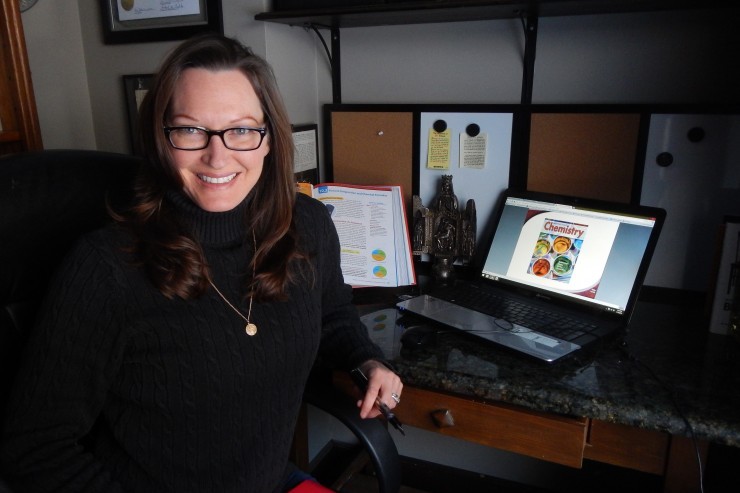I should explain my background before hypothesizing. I taught high school chemistry in a Texas public school in the 1990’s for two years. I was 21, three years into a biology degree, and had taken no education classes because I had no plans to teach. But science teachers were in demand, the university granted me a Broadfield Science bachelor degree, and I became a teacher. I fell in love with chemistry, so much so I went back to school. In graduate school, I taught university chemistry labs for two years. Then I worked for DuPont. Then I left my career in 2003 to be a homemaker. Over the last five years, with a baby in my lap and through an Avagodro’s mole of diaper-changes, sippy-cup refills, and piles of laundry, I completed an online degree in theology. Now I teach chemistry online for a high school program and a college chemistry course for an undergraduate online program, both of which are Catholic institutions. My children have attended public school, parochial school, and home school over the last 25 years. I currently home educate our five youngest. While my experience is sporadic, varied, and some of it newly acquired, I have a good set of data points to compare. For the scientist in me, that’s enough to make some observations and predictions.
The Student-Teacher Interaction
This seems to be the first question anyone has about online education. How can the students and teacher possibly interact online the same way they can face-to-face in a classroom? Imagine these scenarios.
In a classroom, the algebra teacher faces the students and begins class. She asks the students to take out homework and pass it up, gives a short quiz to test for mastery, and then fills the rest of the 45 minutes with lecture wherein she works problems on the chalkboard and the students take notes. She calls on them to answer questions. They raise their hands to ask questions. There is interaction. There is back and forth. But there’s also Student A who waits to show off rather than contribute, distracting the others. There’s Student B who is insecure about her appearance, and who cannot help comparing herself to her peers instead of focusing on algebra. There’s Student C who works late and has trouble staying awake, so he sleeps in the back. There’s Student D who doesn’t understand, but is too embarrassed to speak up so she takes notes, tries to do the homework, barely passes, and remembers nothing about the class 20 years later except that she hated it. As long as Students E-T (the other 16) are paying attention, engaging in the material, and as long as the teacher is acknowledging them, to an observer plenty of good student-teacher interaction appears to happen.
Now put those same people in an online classroom. Each student is sitting at a home desk in front of a computer or tablet. Our Student A has no one to show off in front of, and if he tries to act up in the online environment the teacher can stop it with a click of a key. Diffident Student B may as well be happily sitting in her PJ’s by the fireplace. Student C may responsibly ask permission to skip class and watch a recording of it later. Student D can watch the lecture in silence. She can watch the recording of it over and over, pausing and replaying the sections where she needs time for the new information to sink in. She can email the teacher for help in privacy. Since only her parents and her teacher will know she is struggling, she feels confident enough to ask for help. Students E-T can still interact in much the same way people interact on internet forums. They can pose questions in writing or over the microphone. The class doesn’t end when the meeting ends either. It is ongoing, residing on software always accessible to the student and teacher.
So about student-teacher interaction? What I’ve observed is that online teaching puts the focus smack on the student-teacher interaction and reduces the influence of everything else. Are there problems with communication? Of course. There are many of the same problems in both environments (removing distractions, providing diversity of teaching tools), but there are solutions. A teacher online, just like any teacher, has to figure out how to impart knowledge, inspire students, and assess mastery.
What It’s Like Day-to-Day
This scenario is real. While my kids do their school work, I do prep work and grading, off and on, as time allows during the day. Fifteen minutes before my chemistry class starts, I log in to the online meeting room so the students can arrive and test their microphones. I go to the education site where I store the lesson plans, attendance records, assignments, quizzes, and exams. I check on their homework assignment to see how they did. (It’s similar to reading a Facebook thread, only the “comments” are student’s homework responses.) I upload a PowerPoint file I have prepared, which I point to as I lecture at my virtual podium. When class begins, I turn on my mic, and speak into the computer, “Hello, class. This is Mrs. Trasancos. We’re going to start with a prayer.” And we pray because the school is Catholic. (My favorites are the Memorare and the prayer to St. Michael the Archangel.) They type “Amen” in the chat box. I give announcements. “Exam III will be in three weeks. You have a a lab this week in the Virtual ChemLab. I am so pleased with your quiz results. Please email me if you would like to redo a quiz and earn a better grade.” Then I teach the material. The students ask questions in the chat box. Many of them email me later for more help. Through all of it, I’m at my home desk. They are at theirs, scattered around the country.
Occasionally, my youngest son runs into the room and my whole class hears him ask for chocolate milk because he cannot understand that behind that computer screen, Mommy is talking to a group of people. Once he burped. Once he wanted popsicles, four. Once his sisters hurt his feelings. Once he wanted to know why he existed. The students have come to expect a little comic relief. Occasionally, a student loses an internet connection, but he logs back on or watches the recorded class later. Occasionally, a student has to step away because a sibling needs something, but the material is there for her to review later. Quite often students have travel plans, but since all they need is their tablet or computer, they are able to join or make up the class easily. And we go on. The distractions are manageable, maybe even more so than if we were all sitting in the same room together.
As we go through the material over the course of the semester, some students need videos to help them grasp the concepts. Some need additional links to more information. Some need a bullet list of steps to work problems. Some need me to work out the problems in various ways. Some need to ask the very small, kind of silly question that is the string that flicks on the mental light bulb. Some just need encouragement and perspective when the work is hard and boring: “I know this is not fun. I know you could copy and paste and pretend you were learning, but if you did, you’d only be wasting your time. Sometimes it’s just like when you were learning to add big numbers in first grade. At first, it seems overwhelming and a whole page of math problems makes you want to cry. But you sit there, you work them, you stick with it, and by the end of the page, by George, you’ve got it. You have to try. I want you to learn this. Even if you never become a chemist, I want you to know about the order in nature at the atomic level, the order God created. It’s all around you.” Already I’ve witness those “Aha!” moments that teachers live for, and I had the satisfaction of knowing I taught someone something, all online.
What I’ve observed is that it is possible to teach, and teach well, online. The success fundamentally hinges on the same thing as in a classroom. The teacher has to want to teach. The students have to want to learn. The teacher needs to inspire and explain. The students need to engage and work. No one can be gathered there just to pass the time, and in a public school where students march from room to room for instruction, passing time is often is the goal.
Online Education Fills a Need
I’m not saying this is the only way to educate, not at all. Public schools are good for some parents and students. Parochial schools are great for others. Home education works just splendidly for others. But I’ve noticed a growing need for something else, something in between. Home schooling is pretty manageable when students are in elementary school, but when they are older the material is more specialized and more difficult. What if you want to home school, but you also want a class here and there? What if you want a biology teacher because you are a literature major, not a biologist? Or you want a history teacher because you are a biologist but not a historian? What if you want to teach your child Latin or calculus, but haven’t got a clue where to begin? What if you just need your child to have other authority figures? More broadly, what if you live where your educational choices are severely limited?
Online education fills those gaps. For Catholics, it also allows faithful students, parents, and teachers to connect in ways they could not connect without the internet, and to educate the way Catholics want to educate, with prayer and praise to God in all we do. I love to teach. I especially love to teach science in the context of faith. But the fact is, I could not teach if I had to leave home to do it.
But does staying home to learn inhibit social skills for kids? Well, there are lively debates about socialization and home school, but I will rely on my experience here. I think learning to interact online is a valuable social tool and job skill. Teaching and learning online is much like my work structure was at DuPont in the 1990’s and early 2000’s. I had a desk and a lab, but my office was my helm. I designed research projects there, but then I communicated with labs around the world to run tests and gather data. I consulted with team members over conference calls and shared internet documents. Most of the people I worked with were in other states and even on other continents. Routinely, if not daily, I interacted with colleagues in Europe, China, or Mexico, or in Wilmington, DE. I had to be able to gain and transmit knowledge communicating with people I never met face-to-face. That is how global industries function.
I predict that in the coming years, we will see a growth of online classes for high school and college students, and possibly even for elementary students. I think Catholic institutions in particular will lead those efforts just like Catholics have always led educational efforts, and I think those efforts will reach around the globe more than ever. Education for us is not just about getting jobs, though supporting our families is certainly important. Education is more; it is about learning, communion, love of neighbor, and striving to grow in virtue because we worship the Trinitarian God. Can you tell I’m excited to be part of this effort? If you have any ideas to share or questions to ask, true to what I’ve promoted here, I welcome your email (stacytrasancos@msn.com).















